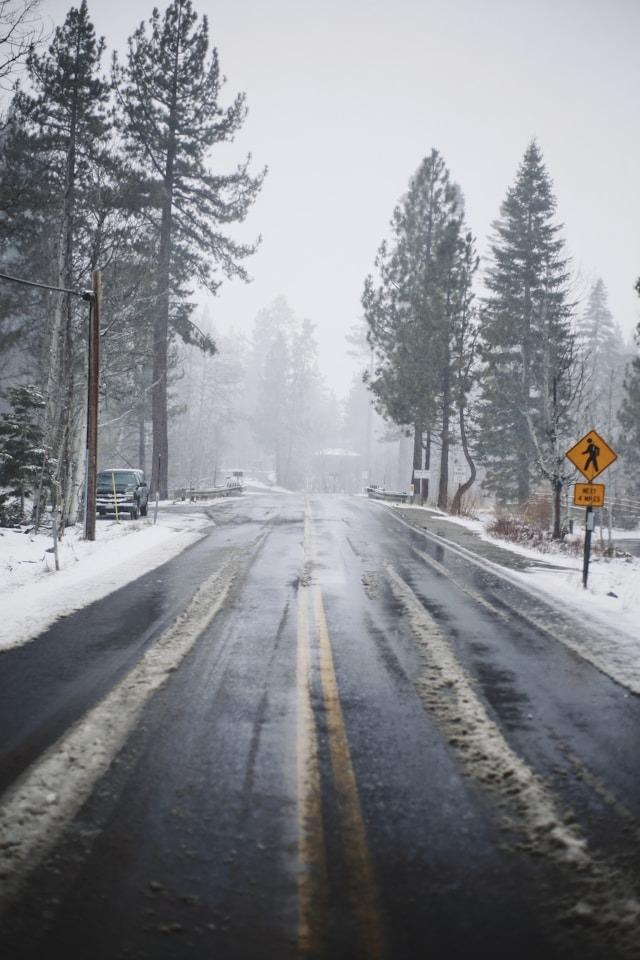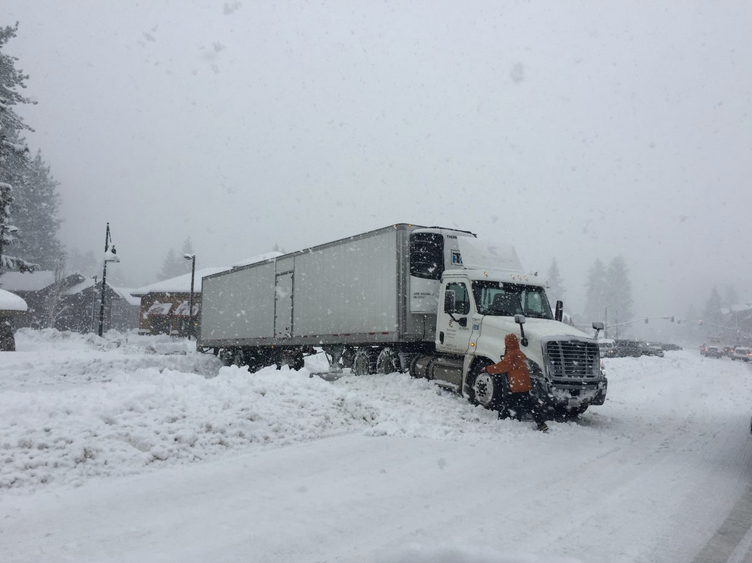We put this one-stop guide together (complete with links, resources, and tips) to help answer any questions regarding winter driving in South Lake Tahoe.

We will break this down into the following key categories!
- General Winter Driving Tips
- Winter Pre-Travel Checklist
- Chain Control
- How to Check Road Conditions & Weather
- Snowplow Safety
- Resources/Link List
Follow these basic rules for winter driving and stay safe while traveling in Lake Tahoe
- WEAR YOUR DANG SEATBELT!
- Slow down and give plenty of space to the vehicle in front of you
- Give yourself 2x the normal travel time
- Turn off cruise control
- If your vehicle begins to slide while driving on snow or ice, stay calm! Slowly take your foot off the gas pedal, do not use your brakes, and steer your vehicle in the direction you wish to travel. If you must use brakes, gently pump the brake pedal and do not allow them to lock up. If your vehicle has anti-lock (ABS) brakes, apply firm, steady pressure without pumping.
- Be aware of black ice, fog, falling snow/ice, flooding, cones, and snow removal equipment. There will be more hazards than low visibility - stay off your phone, and keep your eyes on the road!

For more great information on winter driving, download the PDF below!
Here's a quick checklist you can use before making the trek to the mountains!
- Check the weather and road conditions in advance (and once more right before!) leaving for the mountains
- See the links at the bottom for easy access to helpful websites!
- Flexible departure time (NEEDING to leave = bad decision making!)
- Highway 50 is busiest between 9AM-3PM - if you can leave earlier/later (weather dependent), it is encouraged. This is to avoid traffic and ensure more space between other vehicles/snow removal equipment.
- If in doubt, why risk it? Consider staying one extra night at one of our properties
- Car walkaround (Brakes/tires, windshield wipers/fluid, defroster/AC)
- Ice scraper, jumper cables, and tire chains
- Full tank of gas
- Plan for no cell service
- WATER! Bring enough for 48 hours
- Snacks (non-perishable is best!)
- Jackets, blankets, snow boots, gloves, hats
- Fully charged devices + bring a car charger
Tahoe has 3 levels of chain requirements, typically in Level 1 or 2. If you see Level 3, you should SERIOUSLY consider delaying travel.
Level 1 - Chains, traction devices or snow tires are required on the drive axle of all vehicles except four-wheel/ all-wheel-drive vehicles.
Level 2 - Chains or traction devices are required on all vehicles except four-wheel/all-wheel-drive vehicles with snow-tread tires on all four wheels.
(NOTE: Four-wheel/all-wheel-drive vehicles must carry traction devices in chain control areas.)
Level 3 - Chains or traction devices are required on all vehicles, no exceptions.
-479A35A1-0F4F-41A2-B9AF7DEE486B447D.jpg)
How to know if chain controls are in place:
Road signs
Closures/checkpoints
Social media, news, Apple/Google (Avoid WAZE!!!)
If you use a chain installer (people on the side of the road at install checkpoints who will do the job for you), ensure that you get their badge number/licensing information!
NOTE: They are NOT affiliated with CalTrans.
Practice putting your chains on BEFORE you ever need to. You don't want to struggle to put them on/lack confidence in the installation when doing it for real!
Speed limit with chains ranges between 20-30 MPH (But please don’t use cruise control; this can be dangerous with bad road conditions)
Checking the road conditions and weather in advance is the first step in safe winter driving. Check a day or two before leaving to see what the general weather forecast looks like. Then, on the day of travel, look at the drive times and other resources (listed below) to ensure that it still makes sense to travel!
You can access road conditions at TahoeRoads.info or use the official CalTrans website for road conditions, chain control, and other information. We shared the links below for easy bookmarking access!
We wish we didn't have to write this section, but unfortunately, common sense gets thrown out the window when people get stuck in traffic behind a plow.

This is taken from the Visit South Lake Tahoe website - it is written so well we don’t think it makes sense to rewrite it. Read it, abide by the tips, and stay safe this winter!
- Always use caution when following, passing or approaching snow removal equipment
- Drive a safe distance behind snowplows. Plows often travel slower than other vehicles to remove snow, apply sand and liquid anti-icers, and assist stranded vehicles.
- Before attempting to pass snow removal equipment, check the direction of snow discharge to avoid snow and debris thrown from the equipment. Remember that plows are wider than most vehicles, and portions of the plow and blade may be obscured by blowing snow.
- Don’t crowd the plow. Only pass snow removal vehicles when a safe, legal passing area is available and adequately clear of snow and/or treated with salt and sand.
- Don’t travel beside a snowplow. They can shift sideways after hitting snow packs or drifts. Plows also are not able to automatically stop sanding when other vehicles pass. Therefore, sand may unintentionally hit vehicles if not driven a proper distance from snow removal equipment.
- When a plow approaches you, allow the plow room to operate by reducing speed and moving to the right side of the road if there is room to do so safely.
- Do not brake with unnecessary sudden movements when in front of a snowplow – plows cannot stop as quickly as an automobile.
- Don’t drive through whiteout conditions caused by swirling snow around a snowplow. Safely pull to the side or slow to allow visibility to improve.
- Remember that a snowplow operator’s field of vision is restricted. You may see them, but they may not see you!
Bookmark this page for quick access to these helpful resources for safe winter travels in South Lake Tahoe!
CURRENT TAHOE WEATHER FORECAST
Get stuck in the mountains? Find a great place to stay in South Lake Tahoe with Adventure Stays!




